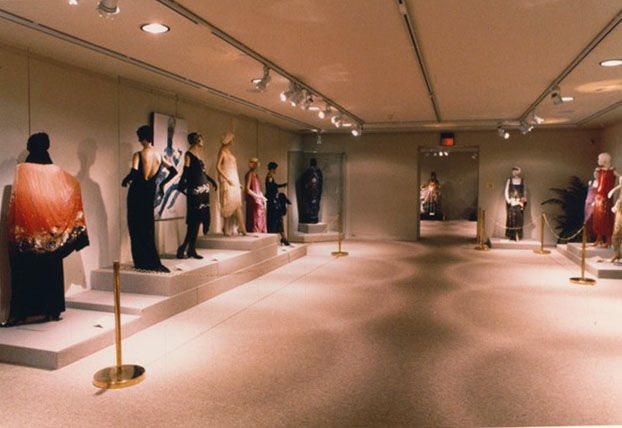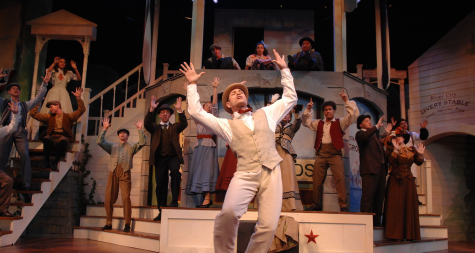Rodgers and Silverman: The lives of Kent State’s influential fashion duo
March 1, 2017
In 1982, a pair of donors gave Kent State a gift that stunned residents, students and fashion collectors worldwide. Jerry Silverman and Shannon Rodgers donated more than 5,000 artifacts, costumes and accessories to the aptly-named Kent State University Museum.
Today, students are greeted with lifelike sculptures of the duo upon walking into Rockwell Hall, but many are left curious as to the lives that led to one of the defining moments of the university.
A kid from Ohio
Rodgers was born in 1911 in Newcomerstown, Ohio, and began his career in fashion by styling costumes for plays and musicals at the Cleveland Playhouse. Shortly after, Rodgers transitioned under Bergman Studio in New York after a colleague told him, “Look, you’ve gotta get out of Cleveland, go to New York.”
Shortly after assisting scenery and costumes in the play “The Warrior’s Husband” (starring Katharine Hepburn), Rodgers was contracted by filmmaker Cecil B. DeMille, who asked the producers, “Who did the ornament on the Greek costumes?”
They told him, “A kid from Ohio.”
Under DeMille, Rodgers worked in the costume industry during the ’30s, assisting in designing scenery on some of Hollywood’s biggest sets like “Cleopatra” and “The Adventures of Marco Polo.” Rodgers was dressing the Golden Era’s leading ladies — but was drafted for the war, which put his creativity on hold.
He returned to Hollywood eager to change positions and study jobs. One day while visiting New York City, walking down the street in his uniform, an old friend stopped him.
Museum Director Jean Druesedow said the friend pointed at the building they stood under and said, “You know, there’s a guy hiring upstairs in this building. You really ought to go in and see him.”
Rodgers said no.
Until he heard who the man in the building was.
Martini Designed
In 1938, Silverman left the Levy, Kraus and Lehman law firm despite graduating from Harvard Law School at the age of 16 and began working as an assisting designer for Martini Designed, a clothing company.
During his time at Martini Designed, he rose to vice president and subsequently hired Rodgers to serve as a designer for almost 10 years.
In 1949, Silverman began his own line with Rodgers, named “Jerry Silverman.” Their concept? Market with mom-and-pop stores the same way they treat the high-end department stores and create better women’s clothing.
“And everybody liked him,” Druesedow said. “The business was really, really booming.”
Shannon’s innovative mindset was focused on creating a dress for the American woman that enabled her to never need assisting hands while styling herself. He created simple, functional dresses that were an immediate success in the industry due to the American woman’s lifestyle in the ’50s.
In the 1959 first-season line, eight of the dresses created at “Jerry Silverman” grossed over half a million dollars.
Old Hollywood dreams die hard
With the line’s substantial financial receivings, Rodgers couldn’t help but still be enthralled with the costume industry.
Cora Ginsburg, a major dealer in antique costuming, became Rodgers’ close friend and accomplice in purchasing antique costumes in excellent condition. Rodgers and Silverman rented out a specific loft in Chelsea, New York, just to house their collection.
Over the course of the next 15 years, Rodgers — and sometimes Silverman — collected more than 4,000 garments, accessories, historic artifacts and over 5,000 books.
Druesedow laughed, quoting one of Rodgers’ friends and sellers Madeleine Ginsburg.
“‘Shannon, of course you can buy that. But it’s like dope. Completely addictive. First you buy one, then you buy two, then you buy four,’” Druesedow said. “‘Then you trade two for four more. And for goodness sake, don’t do accessories, and don’t do ethnographic pieces’ — which of course he did.”
Druesedow said there was no question that the collection would be one of the finest in private hands. The line was successful, Rodgers’ eye kept the collection’s value increasing and then, Silverman was diagnosed with cancer.
A large donation in small-town Kent
With the news of Silverman’s cancer, Rodgers set out to place their collection in a museum strongly attracted to his home state in Ohio. The two sold the business and began by contacting the Newcomerstown Historical Society. After speaking with an old friend from his high school in need of fundraising, he was convinced to put on a fashion show tied to Kent State.
Brage Golding, president of Kent State at the time, was thrilled with the idea of mending not only relations between the Kent town and university, but also felt intrigued at how the public responded to the fashion show.
“Brage recognized the real possibility of bridging a chasm,” Druesedow said. “He offered a curriculum in fashion design and merchandising that would utilize the collection. And Shannon said yes.”
But where on campus would the collection idealistically fit? Druesedow said that Golding offered the possibility of Moulton Hall. Shannon looked around Golding’s office, which at the time was the University Library, and said there would be fine.
The two appraised their collection through the State of Ohio at $5.3 million and granting that same amount to renovate the library into what is now known as the Shannon Rodgers and Jerry Silverman School of Fashion Design and Merchandising. Their work was completed and the building officially opened on Sept. 27, 1985.
The museum today
Rodgers and Silverman’s friend Geneva Damron has helped sustain the ongoing process of keeping the museum fresh, innovative and appealing to the masses.
In 1978 and 1980, Damron visited Silverman and Rodgers in their New York City apartment to discuss the gift to the university. She described her visits as always memorable.
Damron said the men were advanced not only in their own style, but for all that exists: friends, movie stars, fine dining, social galas and, of course, clothing.
“To date, I am privileged to have the opportunity to support the gem of Kent State University: the Fashion School and the (Kent State University) Museum,” Damron said. “Jerry and Shannon would be proud of what they have become in 2017.”
Silverman died of cancer in October 1984, less than one year before the museum opened. Rodgers lived to witness the museum coming to fruition, passing in 1996. Rodgers, during the museum’s first impactful years, couldn’t have been happier seeing the collection used and studied.
And that is Druesedow’s work: studying the pair. Having to describe Rodgers in a single word, she chose “showman.”
“I was here for the last few years of Shannon’s life,” she said. “(Every day at) noon, I would pick him up and we would (eat) lunch at the Pufferbelly, and I would hear tales and gleam at all of the stories.”
Current faculty at the museum note that the influence of Rodgers is evident — despite the museum’s history and the ever-evolving world of fashion.
“Much of the collection is shaped by (Rodgers’) interests and ideas. The furniture from their apartments is still part of the collection. Shannon also had a distinctive style in how he presented the exhibitions,” said Sara Hume, associate professor and museum curator. “He was very ostentatious and there are lots of things in the room where we prepare mannequins that we still find that have his style: extra bows and flounces of lace.”
For those still heavily involved in the museum today, the legacy of Rodgers and Silverman lives strong in a place many would never have dreamed fashion would exist.
“My favorite part is having the opportunity to provide people with a chance to see things and learn things that they otherwise wouldn’t have exposure to,” Hume said.
Payton Moore is a features correspondent, contact her at [email protected].

























